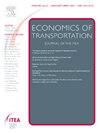Telecommuting and the recovery of passenger aviation post-COVID-19
IF 1.7
3区 工程技术
Q2 ECONOMICS
引用次数: 0
Abstract
Air passenger transport has been dramatically impacted by the COVID-19 pandemic due to lockdown policies and social distancing mandates. However, once restrictions were lifted, air traffic has reverted very slowly to pre-pandemic levels with many markets still recovering from the downturn. We try to understand what causes this sluggish recovery of air passenger transport and ask whether it could be related to structural changes in business and working arrangements post-pandemic. Specifically, we consider if the dramatic shift towards telecommuting and remote work has transformed the nature of business interactions in the marketplace, leading to a negative demand shock for air travel. We use U.S. city-level data on the fraction of jobs that can be performed remotely to proxy for telecommuting, and employ a difference-in-differences estimation method to investigate if air travel demand post-COVID is lower in cities with a larger share of remote work, all else equal. An event study analysis using monthly data evaluates differences in air passenger traffic across cities in the periods leading up to the COVID-19 outbreak and during its aftermath, distinguishing between cities with a higher versus lower share of remote jobs. All the estimation results lend support to the hypothesis that the raise in telecommuting following the COVID-19 pandemic has slowed down the recovery of air travel to pre-pandemic levels.
远程办公与covid -19后客运航空的恢复
由于封锁政策和保持社交距离的规定,航空客运受到COVID-19大流行的巨大影响。然而,一旦取消限制,空中交通量就会非常缓慢地恢复到大流行前的水平,许多市场仍在从低迷中复苏。我们试图了解导致航空客运复苏缓慢的原因,并询问这是否可能与大流行后业务和工作安排的结构性变化有关。具体而言,我们考虑的是,向远程办公和远程工作的巨大转变是否改变了市场中业务互动的性质,从而导致对航空旅行的负面需求冲击。我们使用美国城市级别的数据来代表远程办公的工作比例,并采用差中差估计方法来调查在其他条件相同的情况下,在远程工作份额较大的城市,covid后的航空旅行需求是否更低。一项使用月度数据的事件研究分析评估了2019冠状病毒病爆发前和爆发后各城市航空客运量的差异,区分了远程工作比例较高和较低的城市。所有的估计结果都支持这样一种假设,即COVID-19大流行后远程办公的增加减缓了航空旅行恢复到大流行前的水平。
本文章由计算机程序翻译,如有差异,请以英文原文为准。
求助全文
约1分钟内获得全文
求助全文

 求助内容:
求助内容: 应助结果提醒方式:
应助结果提醒方式:


